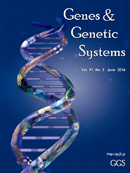
- 6 号 p. 257-
- 5 号 p. 213-
- 4 号 p. 163-
- 3 号 p. 105-
- 2 号 p. 59-
- 1 号 p. 1-
- |<
- <
- 1
- >
- >|
-
2017 年 92 巻 3 号 p. Cover-
発行日: 2017年
公開日: 2018/01/20
ジャーナル オープンアクセスPDF形式でダウンロード (684K) -
2017 年 92 巻 3 号 p. Toc-
発行日: 2017年
公開日: 2018/01/20
ジャーナル オープンアクセスPDF形式でダウンロード (20K) -
2017 年 92 巻 3 号 p. Index-
発行日: 2017年
公開日: 2018/01/20
ジャーナル オープンアクセスPDF形式でダウンロード (399K)
-
Junko Kanoh原稿種別: Full paper
2017 年 92 巻 3 号 p. 105
発行日: 2017/06/01
公開日: 2018/01/20
ジャーナル オープンアクセス HTMLPDF形式でダウンロード (413K) HTML形式で全画面表示 -
Makoto T Hayashi原稿種別: Full paper
2017 年 92 巻 3 号 p. 107-118
発行日: 2017/06/01
公開日: 2018/01/20
[早期公開] 公開日: 2017/10/06ジャーナル オープンアクセス HTMLThe ends of eukaryotic linear chromosomes are protected from undesired enzymatic activities by a nucleoprotein complex called the telomere. Expanding evidence indicates that telomeres have central functions in human aging and tumorigenesis. While it is undoubtedly important to follow current advances in telomere biology, it is also fruitful to be well informed in seminal historical studies for a comprehensive understanding of telomere biology, and for the anticipation of future directions. With this in mind, I here summarize the early history of telomere biology and current advances in the field, mostly focusing on mammalian studies relevant to aging and cancer.
抄録全体を表示PDF形式でダウンロード (967K) HTML形式で全画面表示 -
Hisao Masai, Yutaka Kanoh, Kenji Moriyama, Satoshi Yamazaki, Naoko Yos ...原稿種別: Full paper
2017 年 92 巻 3 号 p. 119-125
発行日: 2017/06/01
公開日: 2018/01/20
[早期公開] 公開日: 2017/06/30ジャーナル オープンアクセス HTMLRecent studies have indicated new roles for telomere-binding factors in the regulation of DNA replication, not only at the telomeres but also at the arm regions of the chromosome. Among these factors, Rif1, a conserved protein originally identified in yeasts as a telomere regulator, plays a major role in the spatiotemporal regulation of DNA replication during S phase. Its ability to interact with phosphatases and to create specific higher-order chromatin structures is central to the mechanism by which Rif1 exerts this function. In this review, we discuss recent progress in elucidating the roles of Rif1 and other telomere-binding factors in the regulation of chromosome events occurring at locations other than telomeres.
抄録全体を表示PDF形式でダウンロード (965K) HTML形式で全画面表示 -
Junko Kanoh原稿種別: Full paper
2017 年 92 巻 3 号 p. 127-133
発行日: 2017/06/01
公開日: 2018/01/20
[早期公開] 公開日: 2017/08/09ジャーナル オープンアクセス HTMLA chromosome is composed of structurally and functionally distinct domains. Telomeres, which are located at the ends of linear chromosomes, play crucial roles in genome stability. Although substantial knowledge of telomeres has been accumulated, the regulation and function of subtelomeres, which are the domains adjacent to telomeres, remain largely unknown. In this review, I describe recent discoveries about the multiple roles of a shugoshin family protein, Sgo2, which is localized at centromeres in mitosis and contributes to precise chromosome segregation, in defining chromatin structure and functions of the subtelomeres in fission yeast. Sgo2 becomes enriched at the subtelomeres, particularly during G2 phase, and is essential for the formation of a highly condensed subtelomeric chromatin body called the knob. Furthermore, Sgo2 maintains the expression levels of subtelomeric genes and the timing of DNA replication at subtelomeric late origins.
抄録全体を表示PDF形式でダウンロード (747K) HTML形式で全画面表示 -
Keiko Muraki, John P. Murnane原稿種別: Full paper
2017 年 92 巻 3 号 p. 135-152
発行日: 2017/06/01
公開日: 2018/01/20
[早期公開] 公開日: 2017/11/22ジャーナル オープンアクセス HTMLIn mammals, DNA double-strand breaks (DSBs) are primarily repaired by classical non-homologous end joining (C-NHEJ), although homologous recombination repair and alternative NHEJ (A-NHEJ), which involve DSB processing, can also occur. These pathways are tightly regulated to maintain chromosome integrity. The ends of chromosomes, called telomeres, contain telomeric DNA that forms a cap structure in cooperation with telomeric proteins to prevent the activation of the DNA damage response and chromosome fusion at chromosome termini. Telomeres and subtelomeric regions are poor substrates for DNA replication; therefore, regions near telomeres are prone to replication fork stalling and chromosome breakage. Moreover, DSBs near telomeres are poorly repaired. As a result, when DSBs occur near telomeres in normal cells, the cells stop proliferating, while in cancer cells, subtelomeric DSBs induce rearrangements due to the absence of cell cycle checkpoints. The sensitivity of subtelomeric regions to DSBs is due to the improper regulation of processing, because although C-NHEJ is functional at subtelomeric DSBs, excessive processing results in an increased frequency of large deletions and chromosome rearrangements involving A-NHEJ.
抄録全体を表示PDF形式でダウンロード (578K) HTML形式で全画面表示
-
Shun Mikuriya, Megumi Kasai, Kenta Nakashima, Natasia, Yoshihiro Hase ...原稿種別: Full paper
2017 年 92 巻 3 号 p. 153-161
発行日: 2017/06/01
公開日: 2018/01/20
[早期公開] 公開日: 2017/06/30ジャーナル オープンアクセス HTML
電子付録Ion beams are powerful mutagens that can induce novel mutants in plants. We previously established a system for producing a mutant population of soybean via ion-beam irradiation, isolated plants that had chlorophyll deficiency, and maintained their progeny via self-fertilization. Here we report the characterization of the progeny plants in terms of chlorophyll content, flowering time and isoflavone content in seeds. Chlorophyll deficiency in the leaf tissues was linked with reduced levels of isoflavones, the major flavonoid compounds accumulated in soybean seeds, which suggested the involvement of metabolic changes associated with the chlorophyll deficiency. Intriguingly, flowering time was frequently altered in plants that had a reduced level of chlorophyll in the leaf tissues. Plant lines that flowered either earlier or later than the wild-type plants were detected. The observed coincidental changes were presumed to be attributable to the following origins: structural changes of DNA segments leading to the loss of multiple gene functions, or indirect effects of mutations that affect one of these traits, which were manifested as phenotypic changes in the background of the duplicated composition of the soybean genome.
抄録全体を表示PDF形式でダウンロード (629K) HTML形式で全画面表示
- |<
- <
- 1
- >
- >|